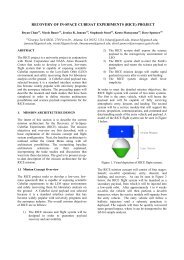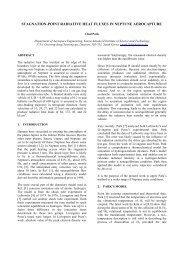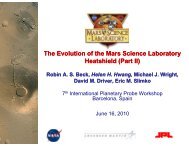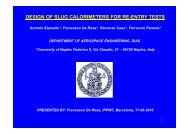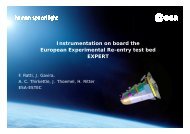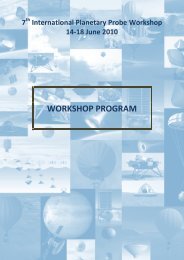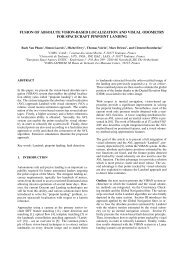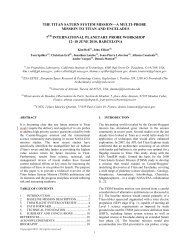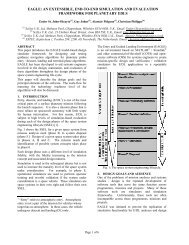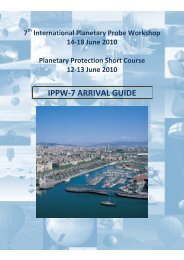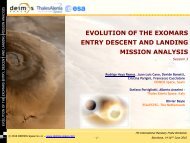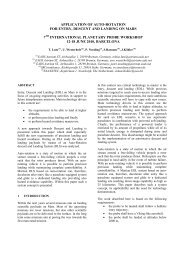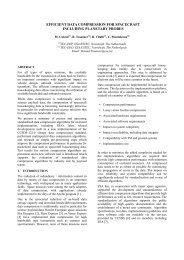x–ray computed tomography inspection of the stardust heat shield
x–ray computed tomography inspection of the stardust heat shield
x–ray computed tomography inspection of the stardust heat shield
Create successful ePaper yourself
Turn your PDF publications into a flip-book with our unique Google optimized e-Paper software.
X–RAY COMPUTED TOMOGRAPHY INSPECTION OF THE STARDUST<br />
HEAT SHIELD<br />
(IPPW-7)<br />
Karen M. McNamara (1) , Daniel J. Schneberk (2) , Daniel M. Empey (3) *, Ajay Koshti (1) , D. Elizabeth Pugel (4) , Ioana<br />
Cozmuta (5) , Mairead Stackpoole (5) , Norman P. Ruffino (6) , Eddie C. Pompa (6) , Ovidio Oliveras (6) and Dean A.<br />
Kontinos (7)<br />
(1) NASA Johnson Space Center, (2) Lawrence Livermore National Labs, (3) Sierra Lobo, Inc., (4) NASA Goddard Space<br />
Flight Center, (5) Eloret Corporation, (6) Jacobs Technology, (7) NASA Ames Research Center<br />
ABSTRACT<br />
The “Stardust” <strong>heat</strong> <strong>shield</strong>, composed <strong>of</strong> a PICA<br />
(Phenolic Impregnated Carbon Ablator) Thermal<br />
Protection System (TPS), bonded to a composite<br />
aeroshell, contains important features which chronicle<br />
its time in space as well as re-entry. To guide <strong>the</strong><br />
fur<strong>the</strong>r study <strong>of</strong> <strong>the</strong> Stardust <strong>heat</strong> <strong>shield</strong> NASA<br />
reviewed a number <strong>of</strong> techniques for <strong>inspection</strong> <strong>of</strong> <strong>the</strong><br />
article. The goals <strong>of</strong> <strong>the</strong> <strong>inspection</strong> were: 1) to<br />
establish <strong>the</strong> material characteristics <strong>of</strong> <strong>the</strong> <strong>shield</strong> and<br />
<strong>shield</strong> components, 2) record <strong>the</strong> dimensions <strong>of</strong> <strong>shield</strong><br />
components and assembly as compared with <strong>the</strong> preflight<br />
condition, and 3) through <strong>the</strong> evaluation <strong>of</strong> <strong>the</strong><br />
<strong>shield</strong> material provide input to future missions which<br />
employ similar materials.<br />
1. INTRODUCTION<br />
The recently returned “Stardust” <strong>heat</strong> <strong>shield</strong> contains<br />
important features which chronicle its time in space as<br />
well as re-entry. To guide <strong>the</strong> fur<strong>the</strong>r study <strong>of</strong> <strong>the</strong><br />
Stardust <strong>shield</strong> NASA reviewed a number <strong>of</strong> nondestructive<br />
techniques for <strong>inspection</strong> <strong>of</strong> <strong>the</strong> <strong>shield</strong>. The<br />
goals <strong>of</strong> <strong>the</strong> <strong>inspection</strong> are: 1) to establish <strong>the</strong> material<br />
characteristics <strong>of</strong> <strong>the</strong> <strong>shield</strong> and <strong>shield</strong> components, 2)<br />
record <strong>the</strong> dimensions <strong>of</strong> <strong>shield</strong> components and<br />
assembly as compared with <strong>the</strong> pre-flight condition,<br />
and 3) through <strong>the</strong> evaluation <strong>of</strong> <strong>the</strong> <strong>shield</strong> material<br />
provide input to future missions which employ similar<br />
materials.<br />
Industrial X-Ray Computed Tomography (CT) is a 3D<br />
<strong>inspection</strong> technology which can provide information<br />
on material integrity, material properties (density) and<br />
dimensional measurements <strong>of</strong> <strong>the</strong> <strong>heat</strong> <strong>shield</strong><br />
components. Computed tomographic volumetric<br />
<strong>inspection</strong>s can generate a dimensionally correct,<br />
quantitatively accurate volume <strong>of</strong> <strong>the</strong> <strong>shield</strong> assembly.<br />
Because <strong>of</strong> <strong>the</strong> capabilities <strong>of</strong>fered by X-ray CT,<br />
NASA chose to use this method to evaluate <strong>the</strong><br />
Stardust <strong>heat</strong> <strong>shield</strong>.<br />
Personnel at NASA Johnson Space Center (JSC) and<br />
Lawrence Livermore National Labs (LLNL) recently<br />
performed a full scan <strong>of</strong> <strong>the</strong> Stardust <strong>heat</strong> <strong>shield</strong> using a<br />
newly installed X-ray CT system at JSC. This paper<br />
briefly discusses <strong>the</strong> technology used and <strong>the</strong>n presents<br />
<strong>the</strong> results <strong>of</strong> <strong>the</strong> scans obtained along with<br />
comparisons <strong>of</strong> <strong>the</strong> scan data with data obtained from<br />
samples cut from <strong>the</strong> <strong>heat</strong> <strong>shield</strong> as well as<br />
comparisons with <strong>the</strong> as-built dimensions. Density<br />
variation, “char” layer thickness, recession and bond<br />
line (<strong>the</strong> adhesive layer between <strong>the</strong> PICA and <strong>the</strong><br />
aeroshell) integrity are all evaluated. Finally<br />
suggestions are made as to future uses <strong>of</strong> this<br />
technology as a tool for non-destructively inspecting<br />
and verifying both pre and post flight <strong>heat</strong> <strong>shield</strong>s.<br />
Fig. 1 - Stardust Capsule.<br />
Industrial X-Ray Computed Tomography is a 3D<br />
<strong>inspection</strong> technology which can provide information<br />
on material integrity and dimensional measurements <strong>of</strong><br />
<strong>shield</strong> components and component materials.<br />
Computed tomographic volumetric <strong>inspection</strong>s can<br />
generate a dimensionally correct, quantitatively<br />
accurate volume <strong>of</strong> <strong>the</strong> <strong>shield</strong> assembly. CT<br />
reconstructed data is comprised <strong>of</strong> volume elements or<br />
“voxels” at each 3D position in <strong>the</strong> volume covering<br />
<strong>the</strong> object under <strong>inspection</strong>. For x-ray based CT <strong>the</strong><br />
voxel is in units <strong>of</strong> x-ray attenuation, relative<br />
attenuation for polychromatic sources and total<br />
attenuation for mono-chromatic sources; <strong>the</strong> product <strong>of</strong>
chemical formula and density. Consequently, voxel<br />
intensities measure changes in material composition<br />
and can be used to measure dimensions <strong>of</strong> features,<br />
anomalies and/or component structures.<br />
NASA JSC has recently completed <strong>the</strong> construction <strong>of</strong><br />
an x-ray cell facility that includes two x-ray sources<br />
and two detectors. The two x-ray sources are a<br />
COMET 450 KVp tube with focal spots <strong>of</strong> 0.4 and 1.0<br />
mm, and a 150 KVp Hamamatsu Micro-Focal source<br />
with three choices <strong>of</strong> x-ray spot (0.05, 0.01 and 0.005<br />
mm nominal). The COMET tube head is on a<br />
manually translatable rail which supports source-todetector<br />
distances from 4 to 12 feet. The Hamamatsu<br />
micro-focal source resides on <strong>the</strong> 4 ft by 6 ft optical<br />
table with <strong>the</strong> THALES Amorphous Silicon detector,<br />
enabling precise positioning for high-cone angle<br />
techniques. Up to three different NEWPORT motion<br />
stages are also on <strong>the</strong> optical table to support different<br />
Computed Tomography and Laminographic scanning<br />
methodologies. Taken as a whole, <strong>the</strong> two x-ray<br />
sources, <strong>the</strong> manual and computerized motion; <strong>the</strong> JSC<br />
X-ray capability can scan a large variety <strong>of</strong> objects, at a<br />
wide range <strong>of</strong> spatial resolutions, and employing a<br />
range <strong>of</strong> scanning techniques.<br />
2. SCANNING METHODOLOGY<br />
The diameter <strong>of</strong> <strong>the</strong> Stardust <strong>shield</strong> is 81 cm (32 in.)<br />
with <strong>the</strong> overall shape <strong>of</strong> a blunted 60° half angle<br />
sphere cone.. Fur<strong>the</strong>r, <strong>the</strong> Stardust <strong>shield</strong> can be<br />
described as constituted <strong>of</strong> 3 layers; 1) an outer PICA<br />
layer, 2) an Aluminum honeycomb layer and 3) a<br />
support substructure <strong>of</strong> aluminum posts and interior<br />
cross-members. Inspection questions span <strong>the</strong> different<br />
components <strong>of</strong> <strong>the</strong> <strong>shield</strong>; what is <strong>the</strong> material state <strong>of</strong><br />
<strong>the</strong> PICA, what is <strong>the</strong> material thickness, and is this<br />
thickness greater or less in different parts <strong>of</strong> <strong>the</strong> <strong>shield</strong>?<br />
Is <strong>the</strong>re a change in <strong>the</strong> material composition <strong>of</strong> <strong>the</strong><br />
PICA close to <strong>the</strong> exterior surface? What is <strong>the</strong><br />
magnitude <strong>of</strong> this change? Are <strong>the</strong>re any unexpected<br />
anomalies in <strong>the</strong> Aluminum honeycomb? And, what is<br />
<strong>the</strong> state <strong>of</strong> <strong>the</strong> bond-line between <strong>the</strong> PICA and <strong>the</strong><br />
Aluminum honeycomb.<br />
The 450 kVp scanning system at JSC includes motion<br />
can accommodate 4 different scanning modes. Figure<br />
2 contains <strong>the</strong> different alternatives. Given <strong>the</strong> large<br />
size <strong>of</strong> <strong>the</strong> Stardust <strong>shield</strong> as compared to <strong>the</strong> 40 by 30<br />
cm (approximately 16 by 12 in.) size <strong>of</strong> <strong>the</strong> Flashscan<br />
33 detector, we elected to implement a ‘tiled-scan”<br />
strategy. The impact <strong>of</strong> this choice is ra<strong>the</strong>r long scan<br />
times; <strong>the</strong> total scan time equals <strong>the</strong> time for a single<br />
scan multiplied by <strong>the</strong> number <strong>of</strong> tiles. Secondly, <strong>the</strong>re<br />
is <strong>the</strong> added complexity <strong>of</strong> positioning <strong>the</strong> detector<br />
with sufficient precision to construct a “joined” scan<br />
that does not include artifacts from <strong>the</strong> “joining”<br />
operation. The source-detector geometry for <strong>the</strong> JSC<br />
450 kVp room is cone-beam, requiring <strong>the</strong> detector be<br />
moved to cover <strong>the</strong> entire projected size <strong>of</strong> <strong>the</strong> Stardust<br />
<strong>shield</strong> at <strong>the</strong> detector plane. To reduce <strong>the</strong> number <strong>of</strong><br />
tiles we elected to scan with “half-scan” or “<strong>of</strong>fsetscan”<br />
techniques where we reconstruct <strong>the</strong> entire object<br />
from a field <strong>of</strong> view that covers just over half <strong>of</strong> <strong>the</strong><br />
X-ray<br />
Source<br />
X-ray<br />
Detector<br />
X-ray<br />
Source<br />
X-ray<br />
Detector<br />
ROI Scan – part centered – scanner aligned<br />
Half-Scan – part centered – scanner aligned<br />
X-ray<br />
Source<br />
X-ray<br />
Detector<br />
X-ray<br />
Source<br />
X-ray<br />
Detector<br />
in 4 Tiles<br />
Overlap<br />
Overlap<br />
ROI Scan – single-end – scanner aligned –<br />
180 plus two fan-angles Tiled-CT – part centered – scanner aligned<br />
Fig. 2 - Alternative scanning modes at JSC.<br />
Overlap
object. These two techniques result in a scan<br />
comprised <strong>of</strong> three separate “scan-tiles”, which when<br />
joined toge<strong>the</strong>r and reconstructed produce a 3D CT<br />
volumetric <strong>inspection</strong> data set for <strong>the</strong> Stardust <strong>shield</strong>.<br />
Selected scan parameters for each <strong>of</strong> <strong>the</strong> tiled scans<br />
represent a choice among competing constraints. The<br />
virtual detector is built up from <strong>the</strong> different scans,<br />
resulting in large data sets. Consequently, <strong>the</strong> number<br />
<strong>of</strong> rotational views acquired should be sufficient for <strong>the</strong><br />
constructed detector, not any one tile. It is important to<br />
note also that increasing <strong>the</strong> number <strong>of</strong> views increases<br />
scan time by <strong>the</strong> number <strong>of</strong> tiles. Secondly, alignment<br />
tolerances get more critical with cone-angle which<br />
increases <strong>the</strong> amount <strong>of</strong> precision for positioning <strong>the</strong><br />
detector. Third, we are interested in substantial spatial<br />
resolution, which means <strong>the</strong> source unsharpness (<strong>the</strong><br />
blur due to <strong>the</strong> finite size <strong>of</strong> <strong>the</strong> source spot) needs to<br />
be kept under control. These constraints given, we<br />
elected to scan <strong>the</strong> <strong>shield</strong> with 900 views over 360<br />
degrees. We are looking for spatial resolution in <strong>the</strong><br />
0.3-0.5 mm range, consequently we chose to position<br />
<strong>the</strong> source-object-detector in a low-cone, lowmagnification<br />
configuration. The source to detector<br />
distance was set at 3048 mm, with a source to object<br />
distance <strong>of</strong> 2591 mm, an x-ray magnification <strong>of</strong> 1.176.<br />
The amorphous silicon detector was operated in <strong>the</strong> 1.5<br />
binning mode, resulting in a detector size <strong>of</strong> 0.1905<br />
mm at <strong>the</strong> detector, and with this magnification, <strong>the</strong><br />
voxel size for <strong>the</strong> reconstructed volume could be as<br />
low as 0.162 mm. For <strong>the</strong> virtual detector, comprised<br />
<strong>of</strong> <strong>the</strong> 3 tiles, <strong>the</strong> field <strong>of</strong> view was roughly 570 mm,<br />
resulting in a cone angle <strong>of</strong> this configuration resulted<br />
in a cone-angle <strong>of</strong> 9.4 degrees. Using <strong>the</strong> small spot<br />
from <strong>the</strong> COMET tube head <strong>of</strong> 0.4 mm, <strong>the</strong> estimated<br />
size <strong>of</strong> <strong>the</strong> source unsharpness at <strong>the</strong> object for this<br />
magnification is 0.0704 mm, easily less than <strong>the</strong> 0.162<br />
mm minimum voxel size for <strong>the</strong> reconstructed volume.<br />
Each <strong>of</strong> <strong>the</strong> three 900 view scans was acquired<br />
separately with <strong>the</strong> detector moved in-between scans.<br />
Referring to Fig. 2, <strong>the</strong> center section scan comprised a<br />
ROI scan, and was acquired first to enable a centerreconstruction<br />
to be processing while <strong>the</strong> o<strong>the</strong>r scantiles<br />
were being acquired. Fig. 3 contains individual<br />
radiographs with <strong>the</strong> joined radiograph displayed in<br />
Figure 4. Fig. 5 contains a vertical slice from <strong>the</strong><br />
reconstructed volume for <strong>the</strong> Stardust <strong>heat</strong> <strong>shield</strong><br />
<strong>inspection</strong>.<br />
All 900 radiographs in <strong>the</strong> three tiles were joined into a<br />
radiograph as displayed in Fig. 4. Those 900<br />
radiographs acquired over 360 degrees were <strong>the</strong>n<br />
processed and reconstructed with a modified Feldkamp<br />
reconstruction algorithm for <strong>the</strong> “<strong>of</strong>fset-scan”<br />
geometry illustrated by <strong>the</strong> radiograph in Fig. 5. In <strong>the</strong><br />
course <strong>of</strong> processing <strong>the</strong> data we resampled <strong>the</strong><br />
projection data to support a reconstruction into 0.324<br />
mm cubic voxels (<strong>the</strong> 0.162 mm pixel radiographs<br />
were resampled 2x2). The result is a 2640 by 2640 by<br />
1000 volume <strong>of</strong> voxel elements.<br />
Fig. 3 - First images from <strong>the</strong> three acquired scans.
Fig. 4 - Joined digital radiograph from three tiled scans.<br />
Fig. 5 - Vertical slice from tiled <strong>of</strong>fset-scan.<br />
The vertical slice shown in Fig. 5 shows two <strong>of</strong> <strong>the</strong><br />
main components <strong>of</strong> <strong>the</strong> <strong>stardust</strong> <strong>shield</strong>, <strong>the</strong> PICA and<br />
<strong>the</strong> aluminum honeycomb underneath. Also, notice<br />
some structured noise or artifacts in <strong>the</strong> lower part <strong>of</strong><br />
<strong>the</strong> vertical slice in Fig. 5 which are a combination <strong>of</strong><br />
“streak” artifacts (from <strong>the</strong> long chords in <strong>the</strong><br />
Aluminum and <strong>the</strong> inadequate number <strong>of</strong> views for a<br />
radiographic area <strong>of</strong> this size). Fig. 6 contains a closeup<br />
view <strong>of</strong> <strong>the</strong> center-top <strong>of</strong> <strong>the</strong> vertical slice from <strong>the</strong><br />
reconstructed volume showing <strong>the</strong> type <strong>of</strong> detail<br />
imaged by <strong>the</strong> CT scanning in <strong>the</strong> JSC system. Using<br />
<strong>the</strong> different Aluminum pieces, and <strong>the</strong> drilled holes in<br />
<strong>the</strong> Stardust Shield as reference standards, <strong>the</strong> volume<br />
appears to include accurate dimensions <strong>of</strong> <strong>the</strong> internals<br />
<strong>of</strong> <strong>the</strong> Stardust <strong>shield</strong>.<br />
3. REVIEW AND ANALYSIS OF 3D<br />
VOLUMETRIC DATA<br />
The 3D CT data can be viewed and unpacked in a<br />
number <strong>of</strong> different ways from a number <strong>of</strong> different<br />
orientations. Fig. 7 contains a cross-sectional or<br />
(transverse) slice through <strong>the</strong> Stardust reconstructed<br />
volume. In both Fig. 6 and Fig. 7, notice <strong>the</strong> texture in<br />
<strong>the</strong> slices through <strong>the</strong> PICA, we consider this texture in<br />
<strong>the</strong> images to be an accurate measure <strong>of</strong> <strong>the</strong> variation<br />
<strong>of</strong> <strong>the</strong> fibers in <strong>the</strong> make-up <strong>of</strong> <strong>the</strong> PICA. Also, <strong>the</strong>re<br />
appears to be higher attenuating material sparsely<br />
interspersed within PICA material. Preliminary<br />
analysis <strong>of</strong> <strong>the</strong>se higher-attenuating chunks indicate a<br />
close resemblance to <strong>the</strong> same features found in scans<br />
<strong>of</strong> recently fabricated PICA [1]. Second, notice <strong>the</strong>
small change in attenuation in <strong>the</strong> cross-sectional slices<br />
towards <strong>the</strong> outside boundary <strong>of</strong> <strong>the</strong> PICA, we consider<br />
this change in attenuation to be <strong>the</strong> char layer, a feature<br />
we will examine subsequently. Third, for <strong>the</strong> slices<br />
showing <strong>the</strong> state <strong>of</strong> <strong>the</strong> Aluminum honeycomb, notice<br />
a variation in <strong>the</strong> attenuation in <strong>the</strong> interstitial layer<br />
between <strong>the</strong> honeycomb and <strong>the</strong> PICA. It appears<br />
<strong>the</strong>re are gaps in <strong>the</strong> fill between <strong>the</strong> PICA and <strong>the</strong><br />
Aluminum honeycomb. Fourth, <strong>the</strong>re appears to be<br />
higher attenuating material on <strong>the</strong> outside <strong>of</strong> <strong>the</strong> PICA.<br />
From a visual <strong>inspection</strong> <strong>of</strong> <strong>the</strong> outside <strong>of</strong> <strong>the</strong> <strong>shield</strong>,<br />
this is “dirt” accumulated on <strong>the</strong> <strong>shield</strong> from <strong>the</strong><br />
landing. As expected <strong>the</strong> “dirt” is higher in x-ray<br />
attenuation than <strong>the</strong> PICA. Lastly, notice <strong>the</strong> hole cut<br />
Fig. 6 - Extracted region from verticle CT slice.<br />
in <strong>the</strong> PICA from some destructive analysis work. This<br />
feature provided a useful reference for verifying <strong>the</strong><br />
dimensional accuracy <strong>of</strong> our reconstructed volume.<br />
Four questions have been identified as important for<br />
<strong>the</strong> analysis <strong>of</strong> <strong>the</strong> Stardust Shield; 1) what is <strong>the</strong><br />
thickness <strong>of</strong> <strong>the</strong> PICA layer, and how does it compare<br />
to <strong>the</strong> as-built state <strong>of</strong> <strong>the</strong> <strong>shield</strong>, 2) are <strong>the</strong>re anomalies<br />
Fig. 7 - Transverse CT slice.<br />
in <strong>the</strong> PICA layer and can this data be used to estimate<br />
<strong>the</strong> depth <strong>of</strong> <strong>the</strong> char layer in <strong>the</strong> PICA, 3) what is <strong>the</strong><br />
state <strong>of</strong> <strong>the</strong> bond-line between <strong>the</strong> aluminum<br />
honeycomb and <strong>the</strong> PICA layer, and 4) are <strong>the</strong>re any<br />
features in this data that result from <strong>the</strong> scanning and<br />
processing techniques, <strong>the</strong>mselves, and how could<br />
<strong>the</strong>se techniques be improved upon for scanning<br />
ano<strong>the</strong>r <strong>shield</strong>.<br />
4. MEASUREMENT OF PICA THICKNESS<br />
While <strong>the</strong>re a many ways to measure <strong>the</strong> thickness <strong>of</strong><br />
<strong>the</strong> PICA layer in <strong>the</strong> scanned volume, <strong>the</strong> methods<br />
developed here focus on “point-wise” techniques. That<br />
is, we sought to obtain measurements <strong>of</strong> <strong>the</strong> thickness<br />
<strong>of</strong> <strong>the</strong> PICA from points on <strong>the</strong> surface <strong>of</strong> <strong>the</strong> PICA.<br />
Unlike “shell-extraction” techniques, or “boundaryfitting”<br />
techniques, <strong>the</strong>se methods do not fit to <strong>the</strong><br />
elliptical shape, but ra<strong>the</strong>r attempt to measure<br />
boundaries as <strong>the</strong>y are in <strong>the</strong> data, and calculate <strong>the</strong><br />
difference between <strong>the</strong> boundaries. Our procedure<br />
starts with a “center vertical slice” and <strong>the</strong>n rotates <strong>the</strong><br />
volume to obtain measurements from “center vertical<br />
slices” at a large number <strong>of</strong> angles throughout <strong>the</strong><br />
volume. In this way thickness measurements are<br />
obtained over <strong>the</strong> entire surface <strong>of</strong> <strong>the</strong> Stardust Shield.<br />
The measurement procedure for a center vertical slice<br />
involves three steps; 1) measure <strong>the</strong> coordinates <strong>of</strong> <strong>the</strong><br />
boundary <strong>of</strong> <strong>the</strong> outer PICA layer from <strong>the</strong> center<br />
vertical slice, 2) for <strong>the</strong> same vertical slice, measure <strong>the</strong><br />
boundary <strong>of</strong> <strong>the</strong> inner PICA layer (<strong>the</strong> inner boundary<br />
is bounded by <strong>the</strong> aluminum honeycomb layer), and 3)<br />
measure <strong>the</strong> distance from outer to inner boundary on<br />
<strong>the</strong> line perpendicular to <strong>the</strong> surface <strong>of</strong> <strong>the</strong> outer<br />
boundary. Fig. 8 shows plots <strong>of</strong> <strong>the</strong> outer and inner<br />
boundary contours <strong>of</strong> <strong>the</strong> PICA layer from <strong>the</strong> scan <strong>of</strong><br />
<strong>the</strong> Stardust <strong>shield</strong> obtained from “shrink-wrap”<br />
operations applied to <strong>the</strong> volume. Fig. 9 shows <strong>the</strong><br />
PICA thickness measured from <strong>the</strong> boundaries in Fig. 8<br />
compared with <strong>the</strong> “as-built” thickness. Fig. 10 shows<br />
<strong>the</strong> estimated material loss based on Figs. 8 and 9.<br />
A few trends in <strong>the</strong> material loss in <strong>the</strong> PICA are<br />
apparent from <strong>the</strong> data. First <strong>the</strong> loss <strong>of</strong> material<br />
(compared to <strong>the</strong> assumed build with a constant<br />
thickness) is greater at <strong>the</strong> top <strong>of</strong> <strong>shield</strong> than towards<br />
<strong>the</strong> outer ends. The maximum loss is around 6.3 mm<br />
(¼ inch) in thickness. But as can be seen from <strong>the</strong><br />
outside <strong>of</strong> <strong>the</strong> <strong>shield</strong> <strong>the</strong>re is substantial variation in <strong>the</strong><br />
outer texture with “chunks” <strong>of</strong> <strong>the</strong> <strong>shield</strong> missing,<br />
possible due to <strong>the</strong> impact at landing. However,<br />
independent <strong>of</strong> <strong>the</strong> chunks missing from <strong>the</strong> <strong>shield</strong>,<br />
<strong>the</strong>re appears to be a near-linear decrease in <strong>the</strong> loss <strong>of</strong><br />
<strong>the</strong> PICA material proceeding from <strong>the</strong> top <strong>of</strong> <strong>the</strong><br />
Shield to <strong>the</strong> outside edges.
Fig. 8 – Plot <strong>of</strong> inner and outer boundaries <strong>of</strong> PICA.<br />
Fig. 9 – PICA thickness measurements.
Fig. 10 - PICA thickness loss from nominal thickness <strong>of</strong> 58 mm.<br />
Applying this technique to <strong>the</strong> entire volume involves<br />
rotating <strong>the</strong> scanned volume <strong>of</strong> <strong>the</strong> Stardust <strong>shield</strong>, and<br />
obtaining a sequence <strong>of</strong> center slices at different<br />
rotational angles. Independent <strong>of</strong> <strong>the</strong> debris sticking to<br />
<strong>the</strong> outside <strong>of</strong> <strong>the</strong> <strong>shield</strong>, and small variations in <strong>the</strong><br />
surface <strong>of</strong> <strong>the</strong> <strong>shield</strong>, <strong>the</strong> trends in <strong>the</strong> thickness are<br />
reasonably consistent with <strong>the</strong> indications reported<br />
from a single slice. The center <strong>of</strong> <strong>the</strong> <strong>shield</strong> lost more<br />
material than <strong>the</strong> outer radii <strong>of</strong> <strong>the</strong> <strong>shield</strong>. These<br />
measurements show a material thickness loss <strong>of</strong> 6-6.5<br />
mm in <strong>the</strong> top <strong>of</strong> <strong>the</strong> <strong>shield</strong> apex, and a low as 3 mm<br />
loss close to <strong>the</strong> outside radii <strong>of</strong> <strong>the</strong> <strong>shield</strong> surface. The<br />
variation in <strong>the</strong> material loss from top <strong>of</strong> <strong>the</strong> dome to<br />
<strong>the</strong> outer ends is only slightly non-linear, with <strong>the</strong> loss<br />
in material greatest at <strong>the</strong> dome, with a more rapid<br />
decrease from top <strong>of</strong> <strong>the</strong> dome to <strong>the</strong> ends, <strong>the</strong>n less<br />
loss at <strong>the</strong> ends. It should be mentioned here that <strong>the</strong><br />
drilled holes in <strong>the</strong> <strong>shield</strong> complicate <strong>the</strong>se point-wise<br />
measurements from <strong>the</strong> CT data, where we are<br />
calculating “tangents” to contours and inverse slopes to<br />
<strong>the</strong> tangents, which in itself can be unstable (small<br />
values <strong>of</strong> <strong>the</strong> tangent results in large numbers in <strong>the</strong><br />
inverse).<br />
5. MEASUREMENTS OF THE CHAR LAYER<br />
The “char” layer is a lower attenuating band <strong>of</strong> PICA<br />
material at <strong>the</strong> outer boundary <strong>of</strong> <strong>the</strong> <strong>shield</strong>. Fig. 11<br />
includes an image extracted from <strong>the</strong> top <strong>of</strong> <strong>the</strong> dome,<br />
with <strong>the</strong> grey-level-window set to just span <strong>the</strong><br />
attenuation <strong>of</strong> <strong>the</strong> PICA (<strong>the</strong> “dirt” on <strong>the</strong> outside layer<br />
are all at <strong>the</strong> maximum gray level). Notice <strong>the</strong> subtle<br />
differences in density characteristic <strong>of</strong> this layer. To<br />
obtain a quantitative measure <strong>of</strong> <strong>the</strong> density differences<br />
in <strong>the</strong> charred PICA line-outs were acquired at<br />
different positions indicated on <strong>the</strong> image. Fig. 12 is a<br />
comparison <strong>of</strong> <strong>the</strong> relative attenuation along <strong>the</strong> line<br />
outs. Since <strong>the</strong> char layer occupies <strong>the</strong> region close to<br />
<strong>the</strong> outside boundary, we obtained “shell-extractions”<br />
from <strong>the</strong> reconstructed volume. This process involves<br />
finding <strong>the</strong> outer boundary, <strong>the</strong>n shrinking <strong>the</strong> outer<br />
boundary to intersect a layer at a uniform distance from<br />
<strong>the</strong> edge, <strong>the</strong>reby generating an image <strong>of</strong> <strong>the</strong> internals<br />
<strong>of</strong> <strong>the</strong> Stardust <strong>shield</strong> in exclusively in <strong>the</strong> char layer.<br />
Fig. 13 is an image <strong>of</strong> <strong>the</strong> shell extraction <strong>of</strong> <strong>the</strong> entire<br />
char layer, Fig. 14 is a extract <strong>of</strong> <strong>the</strong> char layer shell,<br />
and Fig. 15 is an extract <strong>of</strong> a layer deeper into <strong>the</strong><br />
PICA.<br />
The variation in <strong>the</strong> attenuation values in <strong>the</strong> above<br />
images and displayed in <strong>the</strong>, images, line-outs, and<br />
histograms shows <strong>the</strong> difficulty in accurately<br />
dimensioning <strong>the</strong> char layer. First, <strong>the</strong>re is variation in<br />
<strong>the</strong> fibers <strong>the</strong>mselves that is close to <strong>the</strong> change in<br />
density in <strong>the</strong> char layer (0.000109 for a mean value <strong>of</strong><br />
0.00214 – approx 1 part in 20). Second, comparing<br />
average values from a shell extraction in <strong>the</strong> char layer<br />
and from a layer inside <strong>the</strong> char (<strong>the</strong> “no-char” region),<br />
<strong>the</strong> “char layer is lower in attenuation by about 12%.<br />
However, referring to Fig. 17, notice <strong>the</strong> substantial<br />
overlap between <strong>the</strong> histograms <strong>of</strong> voxels from <strong>the</strong> char<br />
and no-char layer. This can also be observed in <strong>the</strong><br />
images; some <strong>of</strong> <strong>the</strong> fibers in <strong>the</strong> char layer retain <strong>the</strong>ir<br />
original density.
Fig. 11 - Extracted section <strong>of</strong> top dome showing approximate positions <strong>of</strong> line-outs.<br />
0.0025<br />
0.0024<br />
(mm‐1)<br />
Relative Attenuation<br />
0.0023<br />
0.0022<br />
0.0021<br />
0.002<br />
0.0019<br />
0.0018<br />
0.0017<br />
0.0016<br />
0.0015<br />
0 2 4 6 8 10 12 14 16<br />
Distance (mm)<br />
LineOut‐1<br />
LineOut‐2<br />
LineOut‐3<br />
LineOut‐4<br />
LineOut‐5<br />
Fig. 12 - A comparison <strong>of</strong> <strong>the</strong> relative attenuation from <strong>the</strong> line-outs indicated in Fig. 11.<br />
Fig. 13 - Shell extraction for <strong>the</strong> entire volume in <strong>the</strong> outer char layer.
Fig. 14 – Extracted region from <strong>the</strong> shell <strong>of</strong> <strong>the</strong> outer char layer.<br />
Fig. 15 - Extracted region from <strong>the</strong> shell <strong>of</strong> <strong>the</strong> inner layers <strong>of</strong> PICA well inside <strong>the</strong> char layer.<br />
160<br />
140<br />
120<br />
N <strong>of</strong> Occurences<br />
100<br />
80<br />
60<br />
40<br />
20<br />
0<br />
0.0007 0.0012 0.0017 0.0022 0.0027 0.0032<br />
Relative Attenuation<br />
No‐Char<br />
Char‐Layer<br />
Fig. 16 - Histograms from extracted regions <strong>of</strong> <strong>the</strong> same size from <strong>the</strong> shell extraction data.
Third, and as expected, <strong>the</strong> loss in density in <strong>the</strong> char<br />
layer results in a material that is less uniform than <strong>the</strong><br />
“no-char” region as shown in <strong>the</strong> width <strong>of</strong> <strong>the</strong><br />
histogram for <strong>the</strong> “Char-Layer” voxels.<br />
Using <strong>the</strong> shell extractions we can average along radial<br />
lines, effectively taking line-outs to obtain some<br />
measure <strong>of</strong> <strong>the</strong> depth <strong>of</strong> <strong>the</strong> char layer. Average depth<br />
<strong>of</strong> <strong>the</strong> char layer is 9.8 mm +/- 1mm. Also on average<br />
<strong>the</strong> char layer is greater at <strong>the</strong> positions <strong>of</strong> largest mass<br />
loss, that is, at <strong>the</strong> “dome” region <strong>of</strong> <strong>the</strong> Stardust<br />
Shield. Given all <strong>the</strong> difficulties mentioned above for<br />
distinguishing <strong>the</strong> char layer from <strong>the</strong> “no-char” layer,<br />
and <strong>the</strong> variation in <strong>the</strong> density <strong>of</strong> <strong>the</strong> PICA, this is<br />
admittedly a measurement with substantial local<br />
variation.<br />
Comparisons <strong>of</strong> <strong>the</strong> above numbers with those from <strong>the</strong><br />
cores taken from <strong>the</strong> <strong>heat</strong> <strong>shield</strong> are <strong>of</strong> interest.<br />
Reference [2] estimated <strong>the</strong> combined char layer and<br />
pyrolysis depth to be ~ 11 mm for <strong>the</strong> flank core and<br />
~9 mm for <strong>the</strong> stagnation core, similar to <strong>the</strong> numbers<br />
above.<br />
Fig. 17 - Cross-sectional slice showing PICA, bondlayer<br />
and Honeycomb.<br />
6. STRUCTURE AND ANOMALIES IN THE<br />
BOND LAYER<br />
The “bond-layer” referred to here is <strong>the</strong> layer <strong>of</strong><br />
material in-between <strong>the</strong> PICA and <strong>the</strong> Aluminum<br />
honeycomb. From <strong>the</strong> cross-sectional slices presented<br />
above and below <strong>the</strong> layer is higher in attenuation than<br />
<strong>the</strong> PICA, and is close in attenuation to <strong>the</strong> Aluminum.<br />
Figure Figs. 17 and 18 contain extracted regions from<br />
cross-sectional slices through <strong>the</strong> PICA, <strong>the</strong> section at<br />
<strong>the</strong> top <strong>of</strong> <strong>the</strong> honeycomb and containing <strong>the</strong> bondlayer.<br />
Notice <strong>the</strong> small porosity at about 4 o’clock in<br />
<strong>the</strong> bond-layer in Fig. 17. Also, notice <strong>the</strong> excess<br />
metal in <strong>the</strong> honeycomb.<br />
The cross-sectional slice in Figure 18 shows a gap in<br />
<strong>the</strong> bond-layer at a radial position <strong>of</strong> 3 o’clock. This<br />
void-space in <strong>the</strong> “bond-layer” extends a length <strong>of</strong><br />
approximately 20 mm at this particular position.<br />
Fig. 18 - Cross-sectional slice showing a gap in <strong>the</strong><br />
bond-layer.<br />
.<br />
Fig. 19 - Shell extraction <strong>of</strong> <strong>the</strong> bond-layer.
Fig. 20 - Close-up <strong>of</strong> <strong>the</strong> top <strong>of</strong> <strong>the</strong> image in Fig. 19.<br />
“Shell extractions” utilized above to examine <strong>the</strong> char<br />
layer can be used to evaluate <strong>the</strong> bond-layer in <strong>the</strong><br />
Stardust <strong>heat</strong> <strong>shield</strong>. Using <strong>the</strong> exterior <strong>of</strong> <strong>the</strong><br />
aluminum honeycomb as a boundary we can position a<br />
shell with this contour in <strong>the</strong> geometric position <strong>of</strong> <strong>the</strong><br />
“bond-layer”. Consequently, we obtain an image <strong>of</strong><br />
<strong>the</strong> entire “bond-layer’ in one image. Figs. 19 and 20<br />
show this.<br />
The “shell-extraction” images show a number <strong>of</strong> gaps<br />
in <strong>the</strong> “bond-layer” in <strong>the</strong> Stardust <strong>heat</strong> <strong>shield</strong>. In<br />
general <strong>the</strong> bond-line is better filled at <strong>the</strong> top <strong>of</strong> <strong>the</strong><br />
<strong>shield</strong> than down <strong>the</strong> length towards <strong>the</strong> ends <strong>of</strong> <strong>the</strong><br />
<strong>shield</strong>. In particular for <strong>the</strong> section at <strong>the</strong> top shown in<br />
Fig. 20 <strong>the</strong> bond-layer is only 62% filled, that is 38%<br />
<strong>of</strong> <strong>the</strong> space in <strong>the</strong> bond layer contains substantial<br />
voids. At this point in time <strong>the</strong>se results have not been<br />
compared to <strong>the</strong> as-built data so it is not clear if <strong>the</strong><br />
void-fraction developed over time in service, or <strong>the</strong><br />
void-fraction is as-built<br />
7. ARTIFACTS IN THE CT DATA AND<br />
LESSONS LEARNED<br />
From <strong>the</strong> evaluation <strong>of</strong> <strong>the</strong> entire 3D CT volume two<br />
different types <strong>of</strong> artifacts can be identified which<br />
hamper <strong>the</strong> evaluation <strong>of</strong> certain features in <strong>the</strong> data.<br />
First, <strong>the</strong> sections <strong>of</strong> PICA and aluminum honeycomb<br />
in close proximity to <strong>the</strong> Aluminum support structure<br />
are inundated with troublesome “streak” artifacts. Fig.<br />
21 contains a cross-sectional slice displaying <strong>the</strong>se<br />
effects in <strong>the</strong> reconstructed volume. These artifacts are<br />
<strong>the</strong> result <strong>of</strong> a “lack <strong>of</strong> penetration” <strong>of</strong> <strong>the</strong> longer<br />
sections <strong>of</strong> Aluminum in <strong>the</strong> support structure<br />
combined with <strong>the</strong> proportion <strong>of</strong> “Background Scatter”<br />
[3] characteristic <strong>of</strong> this technique. In many cases<br />
<strong>the</strong>se effects can be remediated by a thicker x-ray beam<br />
filter, <strong>the</strong>reby increasing <strong>the</strong> average energy used in <strong>the</strong><br />
scanning. This should be considered in subsequent<br />
scanning.<br />
increment must be comparable with <strong>the</strong> spatial<br />
resolution <strong>of</strong> <strong>the</strong> radiographic projection to get all <strong>the</strong><br />
Fig. 21 - Cross-sectional slice showing streak artifacts.<br />
resolution available in <strong>the</strong> radiograph into <strong>the</strong> 3D<br />
reconstruction. The ma<strong>the</strong>matics result in <strong>the</strong><br />
requirement that <strong>the</strong> number <strong>of</strong> rotational views be pi<br />
or pi/2 times <strong>the</strong> number <strong>of</strong> spatial resolution elements<br />
out to <strong>the</strong> radius <strong>of</strong> interest. Given that <strong>the</strong> PICA is at a<br />
radius <strong>of</strong> some 900 pixels, it is clear that 900 views are<br />
not adequate to avoid <strong>the</strong> periodic noise resulting from<br />
<strong>the</strong> lack <strong>of</strong> rotational views. The result is an additional<br />
source <strong>of</strong> noise that makes detailed examination <strong>of</strong> <strong>the</strong><br />
PICA in <strong>the</strong> wider sections <strong>of</strong> <strong>the</strong> <strong>shield</strong> more difficult.<br />
In subsequent scans <strong>the</strong> number <strong>of</strong> views should be<br />
increased to 1200 or 1800 views over 360, provided<br />
part-availability and funding exist for this added scan<br />
time.<br />
Ano<strong>the</strong>r type <strong>of</strong> artifact occurs in <strong>the</strong> sections <strong>of</strong> <strong>the</strong><br />
Stardust Shield down from <strong>the</strong> top <strong>of</strong> dome and is due<br />
to <strong>the</strong> lack <strong>of</strong> views acquired. There is a relationship<br />
between <strong>the</strong> radius at which features appear and <strong>the</strong><br />
angular increment used to obtain <strong>the</strong> number <strong>of</strong> views<br />
for <strong>the</strong> reconstruction [4]. In particular, <strong>the</strong> angular
8. SUMMARY<br />
To evaluate <strong>the</strong> structure <strong>of</strong> <strong>the</strong> Stardust Shield a tiled-<br />
CT scan was performed on <strong>the</strong> Stardust Shield in <strong>the</strong><br />
newly fabricated 450 kVp x-ray room at JSC. The<br />
results are varied. First, <strong>the</strong> results show <strong>the</strong> loss in <strong>the</strong><br />
<strong>shield</strong> thickness as compared to <strong>the</strong> as-built thickness<br />
to be 6-6.5 mm in <strong>the</strong> top <strong>of</strong> <strong>the</strong> <strong>shield</strong> apex, and a low<br />
as 3 mm loss close to <strong>the</strong> outside radii <strong>of</strong> <strong>the</strong> <strong>shield</strong><br />
surface. The variation in <strong>the</strong> material loss from top <strong>of</strong><br />
<strong>the</strong> dome to <strong>the</strong> outer ends is only slightly non-linear,<br />
with <strong>the</strong> loss in material greatest at <strong>the</strong> dome, with a<br />
more rapid decrease from top <strong>of</strong> <strong>the</strong> dome to <strong>the</strong> ends,<br />
<strong>the</strong>n less loss at <strong>the</strong> ends. Second, CT data showed<br />
indications <strong>of</strong> a char layer in <strong>the</strong> PICA on <strong>the</strong> outside<br />
<strong>of</strong> <strong>the</strong> Stardust Shield. The density <strong>of</strong> <strong>the</strong> char layer is<br />
less than <strong>the</strong> unaffected PICA by 12%. Also, <strong>the</strong><br />
thickness <strong>of</strong> <strong>the</strong> char layer is on average 9.8 mm +/- 1<br />
mm. This measurement includes substantial local<br />
variations with some <strong>of</strong> <strong>the</strong> fibers in <strong>the</strong> char layer near<br />
<strong>the</strong> attenuation values <strong>of</strong> <strong>the</strong> unaffected PICA. The<br />
nature <strong>of</strong> this variation is difficult to establish without<br />
better data on <strong>the</strong> as-built material. Lastly, a few<br />
troublesome scan artifacts were identified as part <strong>of</strong><br />
<strong>the</strong>se scans. We recommend a thicker x-ray beam filter<br />
and <strong>the</strong> acquisition <strong>of</strong> more rotational views. For tiled-<br />
CT scanning increasing <strong>the</strong> number <strong>of</strong> rotational views<br />
increases <strong>the</strong> scan time by <strong>the</strong> number <strong>of</strong> tiles, and<br />
could result in substantial increased cost. However, if<br />
<strong>the</strong> interest <strong>of</strong> <strong>the</strong> scan is focused on <strong>the</strong> top <strong>of</strong> <strong>the</strong><br />
dome where <strong>the</strong> angular increment and radius<br />
requirements are not as stringent, this scan strategy is<br />
adequate to support <strong>the</strong> variety <strong>of</strong> measurements<br />
presented here.<br />
9. REFERENCES<br />
1. Empey D. M. and Schneberk, D. J., Results from<br />
medium resolution and high resolutions scans <strong>of</strong> PICA,<br />
Working Paper, 2007<br />
2. Stackpoole M., Sepka S., Cozmuta I., Kontinos D.,<br />
Post-Flight Evaluation <strong>of</strong> Stardust Sample Return<br />
Capsule Forebody Heat<strong>shield</strong> Material, AIAA-2008-<br />
1202, 46 th AIAA Aerospace Sciences Meeting and<br />
Exhibit, Reno, Nevada, 2008<br />
3. Schneberk, D. J. and Martz, H., Radiographic<br />
Testing, ASNT Press, 2002<br />
4. Kak A. C. and Slaney M., Principals <strong>of</strong><br />
Computerized Tomographic Imaging, IEEE Press, New<br />
York, 1987<br />
The final recommendation, for future probes requiring<br />
TPS (and returning to Earth), would be to perform a<br />
similar CT scan before launch in order to have<br />
“before” and “after” measurement for comparison.<br />
Some <strong>of</strong> <strong>the</strong> values reported in this paper have<br />
significant uncertainty due to lack <strong>of</strong> exact pre-flight<br />
configuration data. As-built information and<br />
construction drawings were consulted but <strong>the</strong> fine<br />
detail available from <strong>the</strong> <strong>tomography</strong> were absent<br />
resulting in less accuracy than desired.



